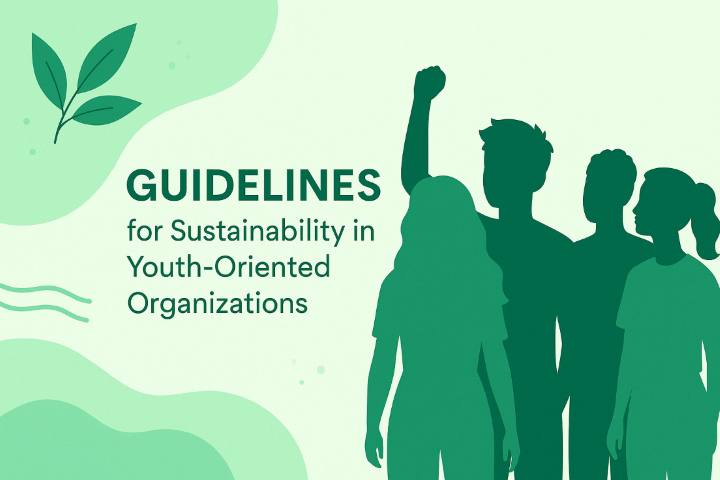Published: August 10, 2025

In the GreenGuard project, organisations working with young people were asked to examine how "greenwashing" presenting vague or misleading sustainability claims undermines trust and mental health. A section of the guidelines notes that many young people report stress, anxiety and guilt when confronted with misleading sustainability claims. As more youth recognise deceptive marketing, misleading environmental messages reduce trust in brands and discourage sustainable behaviour. Young consumers are adapting: they are becoming more selective, researching claims themselves and demanding accountability and transparency from brands. These reactions show why organisations must be clear about their own sustainability practices and help young people differentiate genuine efforts from greenwashing.
The guidelines urge organisations to establish transparent and accountable practices, starting with communications. Sustainability claims should be clear, specific and verifiable to avoid greenwashing. Using recognized third party environmental certifications helps validate efforts. Organisations are asked to look at the entire lifecycle of their products and services, considering environmental impacts from production to disposal. This holistic assessment encourages honest messaging and reduces the risk of misleading statements.
Young people should not be passive recipients of sustainability messaging. The guidelines call for participatory approaches, meaning youth should be involved in planning and implementing sustainability initiatives. Organisations are encouraged to create channels for feedback so that young participants can voice their opinions on policies and practices. By incorporating youth insights, organisations both empower young people and ensure their strategies are relevant.
Sustainability should permeate daily operations, not sit in a separate strategy document. The guidelines recommend providing sustainability education and training for staff and young participants. Organisations are urged to adopt environmentally friendly practices in their operations, such as reducing waste and conserving energy. When sustainability becomes part of an organisation’s culture, it signals authenticity and inspires youth to adopt similar habits.
No organisation can achieve systemic change alone. The guidelines advocate forming partnerships with other organisations, schools and community groups to amplify sustainability efforts. Resource sharing, such as exchanging best practices and tools, builds collective capacity and helps smaller organisations implement sustainable approaches. External resources, such as the Council of Europe’s T Kit 13: Sustainability and Youth Work and UNESCO’s Meaningful Youth Participation toolkit, offer practical frameworks for participation and sustainability.
Water is described as "the essence of life," and the guidelines highlight the need for education and awareness around sustainable water use. Organisations are encouraged to integrate water themes into educational programmes, using experiential learning and storytelling to explain the water cycle and local conservation issues. It is important to audit and improve one’s own practices, for instance by installing low flow taps, using rainwater for gardening and avoiding bottled water. The guidelines also suggest partnering with local experts such as environmental NGOs or water utilities to host talks or field visits. Empowering young leaders by offering mentorship and small grants helps them design and implement their own water conservation projects.
The energy section stresses the link between everyday energy choices and climate change. It proposes integrating energy topics into programmes through workshops and games that explore energy sources and consumption patterns, encouraging youth to track and reduce their own energy use. Organisations should lead by example, switching to LED lighting, eliminating phantom energy through power strips and controlling heating with timers or sensors. Running energy challenges—for example, a month long campaign where youth compete to reduce energy use—motivates behavioural change. Collaborating with engineers, architects or renewable energy start ups can deepen understanding, while creating a "green energy lab" allows young people to prototype energy saving solutions.
The guidelines also offer a self assessment checklist to determine whether an organisation’s space is energy smart, asking about turning off lights, using LEDs, managing electronics, heating efficiently and raising awareness. This evaluation encourages organisations to identify quick wins and develop an improvement plan.
The "Lower the footprint" section emphasises that small, everyday choices add up. Suggestions include walking, cycling or taking public transport instead of using cars; switching some meetings to online; serving local, plant based meals; using plants to improve indoor air quality; powering down devices when not in use; going paperless; and avoiding single use items. The document urges organisations to carefully consider whether new products or services are necessary and to prioritise reuse, repair and sharing. A green procurement checklist helps assess suppliers on criteria like environmental responsibility, credible eco labels and end of life plans. Organisations should look for durable, repairable and locally sourced products, evaluate energy efficiency and ensure that services (from catering to digital platforms) align with sustainability principles. Implementing the checklist in procurement policies and tracking progress promotes continuous improvement.
The final section links waste reduction with biodiversity. It explains that trash in nature harms animals, pollutes water and soil and destroys habitats, while food waste wastes water, land and energy. Organisations can model responsible habits by encouraging the use of reusable bottles, bags and cutlery; buying local, seasonal and organic food; planning meals to reduce leftovers; and composting scraps. The guidelines promote smart consumption—repairing, reusing and reducing packaging, avoiding fast fashion by swapping or thrifting, and choosing natural fibres to cut microplastics. Offices should go digital, reuse supplies, sort waste, hold eco swap events and use native plants and eco friendly cleaners. A week long waste tracking table encourages youth groups to record recyclable and non recyclable waste, reflect on common waste types and set reduction goals. Celebrating reused or recovered items reinforces positive behaviours.
The GreenGuard guidelines emphasise that empowering youth to fight greenwashing and embrace sustainable practices requires transparency, participation and practical tools. Clear, verifiable communication and third party certifications foster trust, while participatory decision making ensures that young people feel ownership of sustainability initiatives. Embedding sustainability into daily operations and collaborating across communities expand impact. Finally, targeted strategies in water stewardship, energy use, green procurement and waste reduction provide concrete pathways for organisations to reduce their environmental footprint while educating and inspiring the next generation.